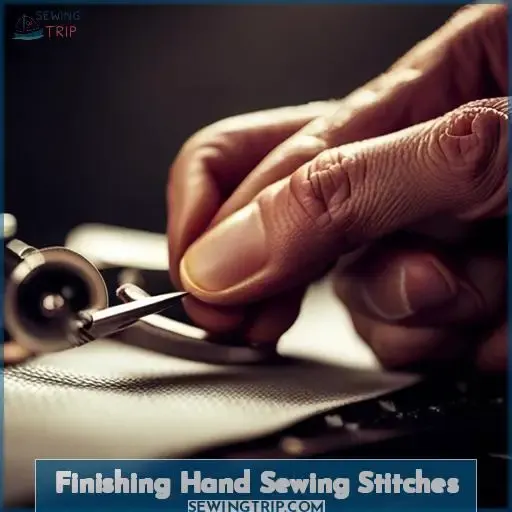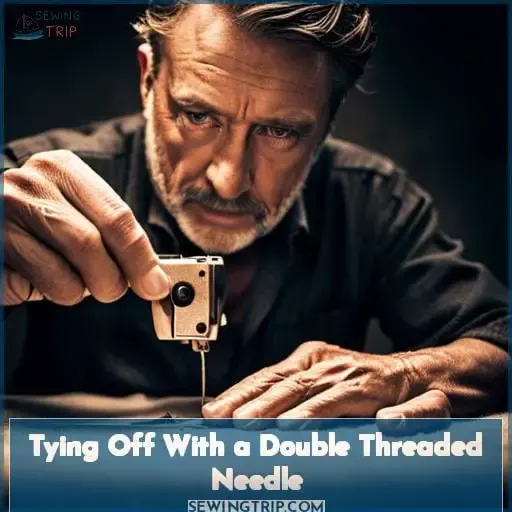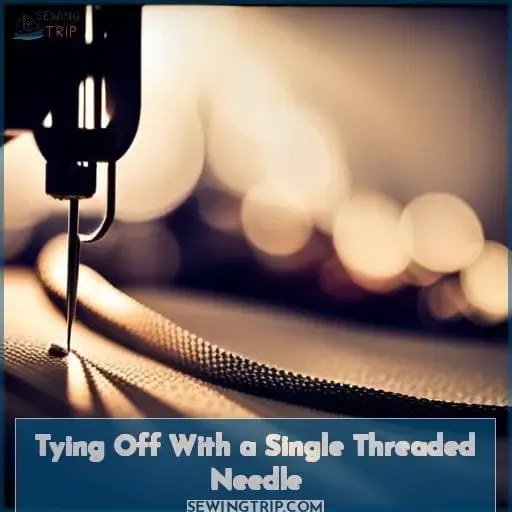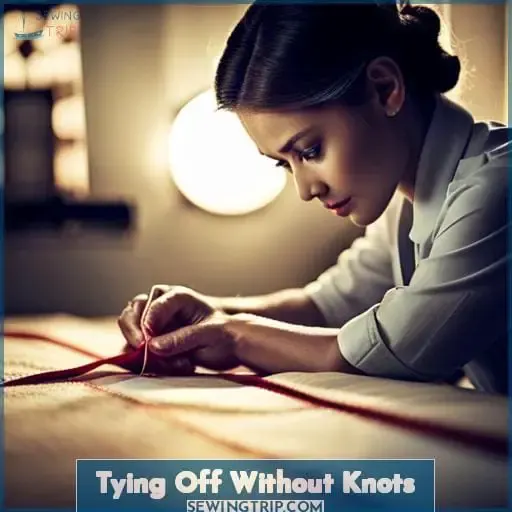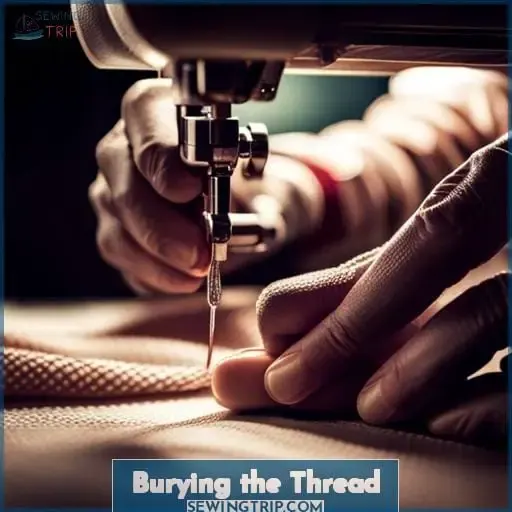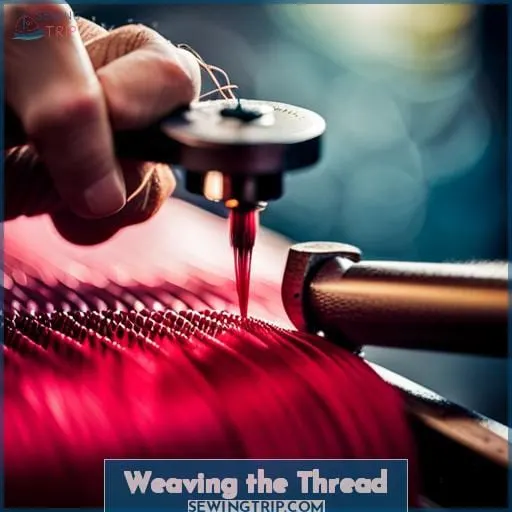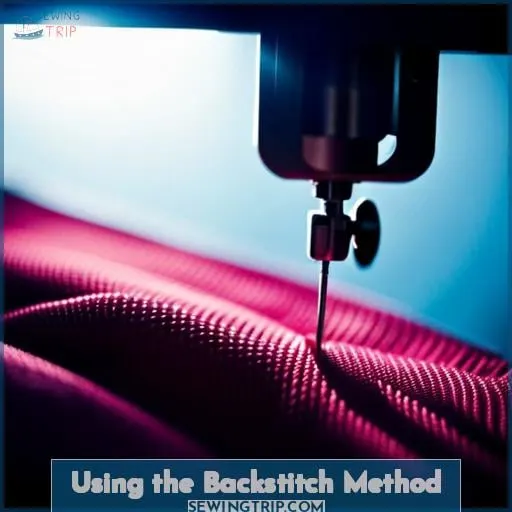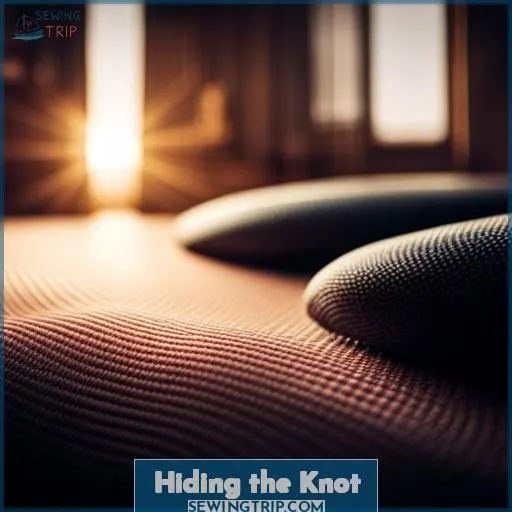This site is supported by our readers. We may earn a commission, at no cost to you, if you purchase through links.
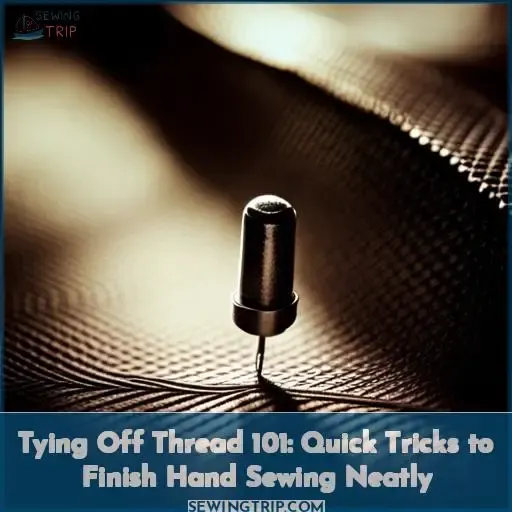
Finishing flourishes fortify fabric’s form when frugal fingers fuse final flourishes.
Folding fabric facings over fretsaws fabric freely, yet fastening thread tails tidily takes time-tested techniques.
Tying off trims tidily takes training, so tailor-tested tricks trim tailings terrifically.
Ready rowdy remnants readily by reviewing recommended resolutions for renouncing ragged renderings when relinquishing robust reams.
Master mending magnificently using methods mentioned momentarily.
Table Of Contents
- Key Takeaways
- Finishing Hand Sewing Stitches
- Tying Off With a Double Threaded Needle
- Tying Off With a Single Threaded Needle
- Tying Off Without Knots
- Special Tying Off for Felt
- Burying the Thread
- Weaving the Thread
- Looping Through Existing Stitches
- Using the Backstitch Method
- Hiding the Knot
- Frequently Asked Questions (FAQs)
- Conclusion
Key Takeaways
- Leave adequate thread length for tying, backstitching, or weaving through existing stitches when finishing sewing.
- Practice different knots or knotless techniques like looping for personalized, professional-looking finishes.
- Adjust thread tension and knot style based on fabric type for optimal durability and aesthetics.
- Use scraps to test tying off and trimming methods before finishing actual projects.
Finishing Hand Sewing Stitches
You’ll want to leave enough thread when ending a stitch so you can tie off or weave the thread to secure it.
Practicing on scrap fabric will help develop techniques for burying knots, looping through prior stitches, or backstitching to complete your work cleanly.
As you gain experience with hand sewing, you’ll learn tricks for finishing stitches neatly.
Play with thread tension, needle techniques, and fabric choices to find creative ways to tie off or hide knots.
Explore knot alternatives like looping through existing stitches or using a backstitch.
Finishing a stitch takes practice, but with time you’ll gain confidence in tying off and concealing threads for polished hand sewing.
Tying Off With a Double Threaded Needle
To tie off with your double-threaded needle, cut the thread below it and tie together the two halves, leaving a couple of inches for simpler knotting.
With excess slack, make three tight knots, starting loose. This allows the thread to cinch up snug.
Vary your knots – square, surgeon’s, or granny – for optimal tension and security based on fabric.
Knot too tight, or the thread will cut the fabric; too loose, and it risks unraveling.
Test knots on scrap material first. Tension is key for a quality finish.
Don’t trim threads too close either. Leave 1/4 inch for some slip.
Mastering double-needle tie-offs takes practice, but it builds expertise in tension, knots, and professional stitch endings.
With time, your hand sewing will achieve both durability and artistry.
Tying Off With a Single Threaded Needle
Leave enough thread to tie a knot (about 3 inches).
Loop thread and hold it down against the fabric.
Keep pulling thread end while holding the loop down.
Knot will become smaller and eventually form.
Trim excess thread for a clean finish.
Proper thread tension and needle control create secure knots.
Play with different knot styles for personalized finishing touches when ending sewing.
Backstitching adds extra stitch security.
Practice helps perfect tying off techniques for professional looking results on all your hand sewing projects.
Tying Off Without Knots
You can also tie off without making a knot.
For a seamless finish with knotless perfection, stitch securing and elegant endings display true thread mastery.
At the end of your sewing, simply make a tiny stitch through both fabric layers where your last stitch ended.
Then reinsert the needle through that same tiny stitch and pull the thread to form a loop.
Pass your needle through that loop and pull until the loop tightens and flattens against the project.
Your stitch is now secured in place.
For added seamless elegance, weave the thread through existing stitches on the backside, looping in and out a few times before clipping it off.
With practice, you’ll achieve the ultimate in knotless thread finesse.
Special Tying Off for Felt
When tying off on felt, you’ll tie a regular knot and butt it against the felt.
Before inserting the needle next to the knot and bringing it out in the middle between the layers, pull on the thread end to tighten and snip it with scissors.
Then let go of the thread end to hide it inside the felt for a clean finish.
This creative technique keeps knots and thread ends from showing on felt projects.
It takes some practice to master the artistry of innovative weaving and tying off on felt.
But with attention to detail and craftsmanship, you can achieve beautiful hand sewing and finishing on felt projects, whether by hand or machine.
Play with colors and textures for artistic knots.
And remember to pull tightly when tying off to ensure durability of your felt creations over time.
Burying the Thread
Although you’d normally tie knots, you can bury the thread between layers to finish hand sewing stitches.
Insert the needle between fabric layers close to the final stitch.
Keep the thread taut and pull the needle through.
Clip the thread end near the exit point.
Gently separate fabric layers to check thread visibility.
Adjust as needed so no thread shows.
This technique conceals knots and creates invisible finishes.
It works for projects with multiple layers like quilts or bags.
Burying the thread finishes stitches cleanly without exposed threads or tails.
What a crafty way to end hand sewing subtly!
Weaving the Thread
However, you can also weave the thread through stitches on the wrong side of the fabric after tying a knot.
Pass your needle in and out of 3-4 existing stitches, pulling the thread taut as you go.
Then, reverse direction and weave back through the same stitches to anchor the thread.
As you weave, consider:
| Thread tension | Needle choices | Stitch variations |
|---|---|---|
| Fabric compatibility | Knot alternatives |
Gently tug the thread once more and use your scissors to clip excess.
This clever approach interlocks with existing stitches for security without bulk.
Test on scraps first to perfect your technique.
With practice, you’ll be adept at inconspicuously finishing projects by weaving and hiding threads.
Looping Through Existing Stitches
You can finish your stitch by looping the thread through a previous stitch.
This creative application secures the thread while leaving no visible knots.
Slide your needle under an existing stitch and pull the thread through to form a loop.
Then, pass your needle through that loop, pulling it tight.
This knotless technique keeps the back neat and tidy for reversible projects.
For troubleshooting, repeat this process under the same stitch if the loop feels loose.
You can creatively vary this advanced finishing technique by choosing decorative stitches to loop under.
A common mistake is pulling too tight and puckering the fabric.
Simply loosening the tension allows the loop to flatten smoothly against the pieces.
Practice first on scrap fabric before expertly looping your threads through prior stitches for invisible endings every time.
Using the Backstitch Method
When finishing by hand, an easy way to tie off is the backstitch.
To do this, insert your needle back through the last stitch and come up behind where the thread exits the fabric.
Give it a good pull to lock the stitch in place before clipping your thread.
Single Backstitch
Through the existing stitch, you’re now ready to lock your final stitch in place using a basic backstitch.
With precision placement, insert your needle exactly where the prior stitch ended, then bring it back up behind the emerging thread.
Carefully pull the thread through, allowing the thread tension to set the stitch length.
With the proper needle angle, this backstitch method secures the knot well beneath the fabric’s surface.
Backstitch With a Loop
Next, you’ll backstitch with a loop to neatly finish your hand sewing.
Insert the needle under the last stitch and bring it back out a short distance away.
Before pulling the thread all the way through, create a loop.
Pass the needle through this loop and gently tighten to form a secure knot.
Loop variations provide flexibility, with more loops adding security.
Compared to basic knots, loops blend into fabrics for smooth aesthetics.
Use loops over knots when discreet finishing is preferred.
Loops suit most applications, especially those needing durability.
Hiding the Knot
When you’re done tying off, tuck the knot between layers or weave it into stitches on the backside to conceal it.
To hide the knot:
- Weave the thread under 3-4 stitches in one direction.
- Loop back and weave through the same path in reverse.
- Pull the thread taut and clip closely.
- Press the seam allowance to encase the tail inside.
Looping techniques like this allow for knot concealing and secure weaving so your finished hand sewing has hidden finishes and neat stitching.
With practice, you’ll be able to tie off threads inconspicuously for a clean look on the front side of your sewing projects.
Frequently Asked Questions (FAQs)
How do I end sewing on delicate or loosely woven fabrics?
When ending stitches on delicate or loosely woven fabrics:
- Use a shorter stitch length.
- Knot threads by looping through prior stitches.
For added strength without large knots:
- Backstitch.
Trim closely, and weave or bury ends securely on the underside to prevent unraveling.
Practice first on scraps to perfect your technique.
What are some quick ways to end stitches when I’m in a hurry?
When in a rush, quickly secure stitches by:
- Backstitching 2-3 times
- Looping thread through a stitch near the end
Then snip close to the fabric.
Practice will help perfect quick ties for durable, clean finishes.
How can I reinforce ending stitches on items that will get heavy use?
For heavy-use items, knot thread ends and weave through several stitches on the backside.
Test your reinforced stitching by lightly tugging.
Add knots or extra weaving if needed.
Backstitching also strengthens ending stitches.
Practice these techniques until they become second nature.
What tools or gadgets can help me end stitches more neatly and evenly?
Trim threads close and tie three knots.
Backstitch or loop through prior stitching.
Thimbles protect fingertips when pulling threads snug.
Practice makes perfect.
Are there any tricks to keeping ending stitches looking neat on the front side of the project?
Knot thread on wrong side.
Weave through existing stitches, or loop under previous stitch and back through.
Avoid large/loose knots.
Check front side as you finish.
Practice gives precision.
Conclusion
Finishing hand sewing swiftly secures seams when you wrap up wearable works wonderfully.
Yanking yarn ends tautly, then tucking threads tidily through textile, terminates tedious tasks terrifically.
So, spool spare strands smartly, slide your needle through fabric façades, and loop leftover lengths liberally to leave your labors looking lovely.
Expertly ending embroidery endeavors elicits elation, so conclude your creative efforts exquisitely by tying off threads tenaciously.
How you end sewing impacts your project’s polish, so finish finessed fabrics fabulously by fastening threads flawlessly.

